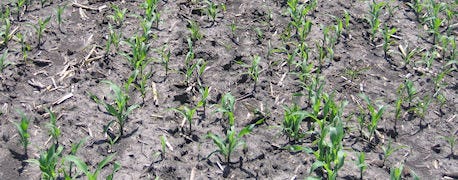May 29, 2013

If you primarily rotate between corn and soybeans -- and grow herbicide resistant varieties and hybrids of both -- you'll soon have to get ready to control volunteer and soybeans.
Volunteer soybeans in corn are relatively easy and cheap to control, says Jeff Gunsolus, University of Minnesota extension agronomist.
But there are some tricks:
Soybean size at time of herbicide application will determine the degree of control with small, V2 to V3 soybeans more effectively controlled than soybeans in the V4 to V6 growth stage.
Application to small plants is especially important if you want to keep your herbicide application rates low.

Use the right herbicide at the right time and you'll clean up fields quickly, before volunteers can reduce yield potential.
Many growers are interested in using 2,4-D to control volunteer soybeans, he says.. However, soybeans are not as sensitive to 2,4-D as they are to the other plant growth regulator herbicides - dicamba or clopyralid.
Another low-cost alternative being discussed by producers is atrazine and would be a better option than 2,4-D due to its crop safety and level of soybean control but is less effective as soybeans enter the V4 to V6 growth stage.
Plant growth regulator herbicides such as Hornet contain clopyralid and should provide effective control to smaller soybeans. Products that contain dicamba, such as Status, Distinct and numerous generics should provide effective control over a wider range of volunteer soybean crop sizes.
~~~PAGE_BREAK_HERE~~~
Volunteer Corn in corn
Control options for volunteer corn in corn are limited and complicated by the fact that most hybrids contain at least one herbicide resistant trait if not more. If a Roundup Ready (RR) hybrid was planted the previous year, glyphosate will not control volunteer corn the following year. Likewise, if a Liberty Link (LL) hybrid was planted the previous year, glufosinate will not control volunteer corn the following year. Glufosinate is an option to control volunteer RR corn, and glyphosate is an option to control volunteer LL corn. However, many hybrids are now stacked with both of these traits, making row cultivation the only option.
Volunteer corn in soybeans
There are several effective herbicides that can be used to control volunteer corn in soybean. Options include products with the ACCase mode of action such as: Assure II (quizalofop), Fusilade DX (fluazifop-P), Select Max (clethodim), and Fusion (fluazifop-P and fenoxaprop) (Gunsolus, 2009). Poast Plus (clethodim) is not as active on volunteer corn as the other products in this mode of action. The ACCase products are generally targeted on 12- to 24-inch tall corn. Another option is the ALS inhibitor Raptor, which is targeted to smaller volunteer corn (2 to 8 inch).
Always check the herbicide label for the appropriate application rate and timing, information about tank-mixing with other products, and adjuvants guidelines. Row cultivation is also a viable option for control of volunteer corn in soybean.
Source: University of Minnesota
You May Also Like




